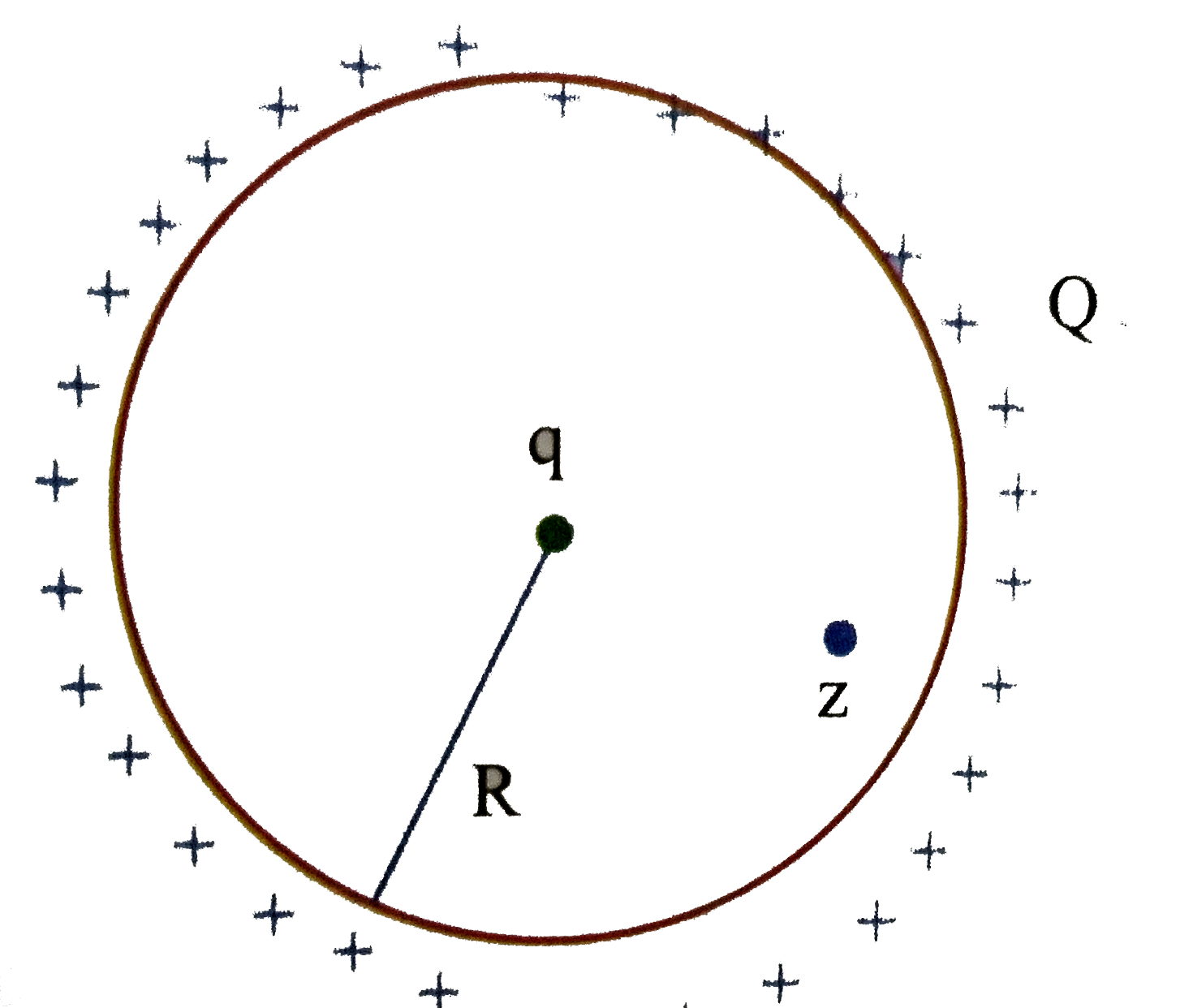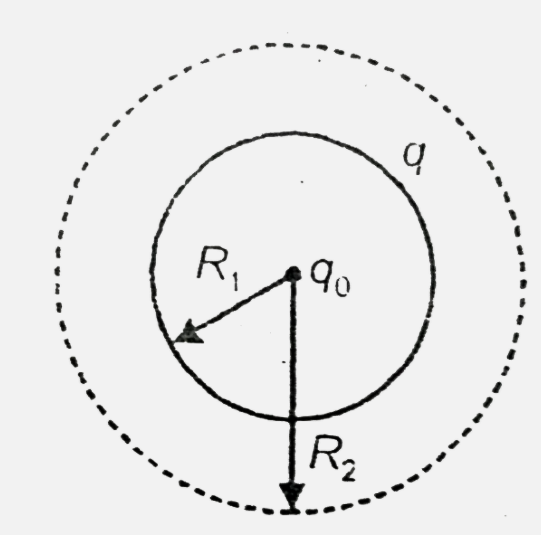The dipole moment of a system of charge +q distribyted uniformly on an arc of radius R subtending an angle π/2 at its centre where another charge −q is placed is :
2√2qRπ
√2qRπ
qRπ
2qRπ
The correct Answer is:A
To find the dipole moment of a system consisting of a charge +q distributed uniformly on an arc of radius R that subtends an angle of π2 at its center, where another charge −q is placed at the center, we can follow these steps:
1. Understand the Geometry:
- We have a quarter ring (arc) of radius R that subtends an angle of π2 at the center. The charge +q is uniformly distributed along this arc.
- The charge −q is placed at the center of the arc.
2. Find the Center of Mass (CM) of the Quarter Ring:
- The coordinates of the center of mass of a quarter ring can be derived from symmetry and are given by:
\(
(x_{cm}, y_{cm}) = \left(\frac{2R}{\pi}, \frac{2R}{\pi}\right)
\)
3. Determine the Distance Between Charges:
- The distance OP from the origin (where −q is located) to the center of mass of the quarter ring (where +q is effectively concentrated) can be calculated using the distance formula:
\(
OP = \sqrt{\left(\frac{2R}{\pi}\right)^2 + \left(\frac{2R}{\pi}\right)^2}
\)
- Simplifying this gives:
\(
OP = \sqrt{2 \left(\frac{2R}{\pi}\right)^2} = \frac{2R}{\pi} \sqrt{2}
\)
4. Calculate the Dipole Moment:
- The dipole moment \( \vec{p} \) is given by the formula:
\(
\vec{p} = q \cdot \vec{d}
\)
- Here, \( q \) is the magnitude of the charge +q, and \( \vec{d} \) is the vector pointing from the charge −q at the origin to the center of mass of the quarter ring.
- Thus, the magnitude of the dipole moment is:
\(
p = q \cdot OP = q \cdot \left(\frac{2R}{\pi} \sqrt{2}\right)
\)
- Therefore, we can express the dipole moment as:
\(
p = \frac{2\sqrt{2} q R}{\pi}
\)
5. Final Result:
- The dipole moment of the system is:
\(
\vec{p} = \frac{2\sqrt{2} q R}{\pi}
\)
- We have a quarter ring (arc) of radius R that subtends an angle of π2 at the center. The charge +q is uniformly distributed along this arc.
- The charge −q is placed at the center of the arc.
- The coordinates of the center of mass of a quarter ring can be derived from symmetry and are given by:
\(
(x_{cm}, y_{cm}) = \left(\frac{2R}{\pi}, \frac{2R}{\pi}\right)
\)
- The distance OP from the origin (where −q is located) to the center of mass of the quarter ring (where +q is effectively concentrated) can be calculated using the distance formula:
\(
OP = \sqrt{\left(\frac{2R}{\pi}\right)^2 + \left(\frac{2R}{\pi}\right)^2}
\)
- Simplifying this gives:
\(
OP = \sqrt{2 \left(\frac{2R}{\pi}\right)^2} = \frac{2R}{\pi} \sqrt{2}
\)
- The dipole moment \( \vec{p} \) is given by the formula:
\(
\vec{p} = q \cdot \vec{d}
\)
- Here, \( q \) is the magnitude of the charge +q, and \( \vec{d} \) is the vector pointing from the charge −q at the origin to the center of mass of the quarter ring.
- Thus, the magnitude of the dipole moment is:
\(
p = q \cdot OP = q \cdot \left(\frac{2R}{\pi} \sqrt{2}\right)
\)
- Therefore, we can express the dipole moment as:
\(
p = \frac{2\sqrt{2} q R}{\pi}
\)
- The dipole moment of the system is:
\(
\vec{p} = \frac{2\sqrt{2} q R}{\pi}
\)
Topper's Solved these Questions
- ELECTROSTATICSBOOK - DC PANDEY ENGLISHCHAPTER - ELECTROSTATICSEXERCISE - Comprehension
36 Videos
- ELECTROSTATICSBOOK - DC PANDEY ENGLISHCHAPTER - ELECTROSTATICSEXERCISE - Matrix Matching
2 Videos
- ELECTROSTATICSBOOK - DC PANDEY ENGLISHCHAPTER - ELECTROSTATICSEXERCISE - Integer
17 Videos
- ELASTICITYBOOK - DC PANDEY ENGLISHCHAPTER - ELASTICITYEXERCISE - Medical entrances s gallery
21 Videos
- EXPERIMENTSBOOK - DC PANDEY ENGLISHCHAPTER - EXPERIMENTSEXERCISE - Subjective
15 Videos
Similar Questions
A positive charge Q is uniformly distributed along a circular ring of radius R.a small test charge q is placed at the centre of the ring.

View SolutionA positive charge Q is uniformly distributed along a circular ring of radius R.a small test charge q is placed at the centre of the ring .The

View SolutionCharge q is uniformly distributed over a thin half ring of radius R. The electric field at the centre of the ring is
View SolutionAn arc of a circle of raduis R subtends an angle π2 at the centre. It carriers a current i. The magnetic field at the centre will be
View SolutionAn arc of radius r carries charge. The linear density of charge is λ and the arc subtends an angle π3 at the centre.
View SolutionA sperical shell is uniformly charged by a charge q. A point charge q0 is at its centre , then

View SolutionA spherical shell of radius R is given charge 3q on its surface and a point charge q is placed at distance R/2 from its centre C. Also there is a charge 2q placed outside the shell at a distance of 2R as shown. Then

View SolutionFour charges equal to −Q are placed at the four corners of a square and a charge q is at its centre. If the system is in equilibrium the value of q is
View SolutionA dipole of dipole moment P is kept at the centre of a ring of radius R and charge Q. If the dipole lies along the axis of the ring. Electric force on the ring due to the dipole is : (K=14πε0)
View SolutionPositive charge Q is distributed uniformly over a circular ring of radius R. A particle having a mass m and a negative charge q, is placed on its axis at a distance x from the centre. Find the force on the particle. Assuming x is very less than R, find the time period of oscillation of the particle if it is released from there.
View Solution
